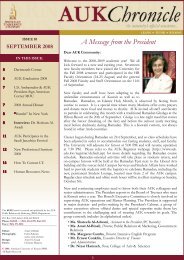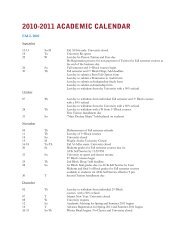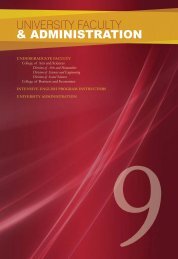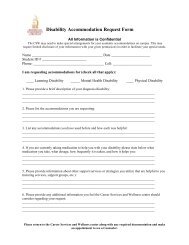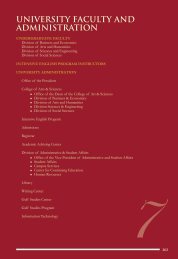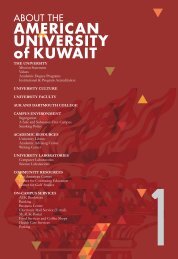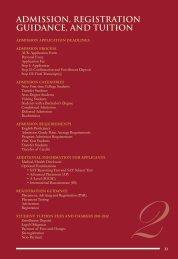academically unprepared…you must be prepared to workhard to compensate. Failure to do so should mean failureto stay the course.” He goes on to say, “Our job is notto retain, but to retrain. And if our basic trainees areunwilling or unable to accept the training, then we can’tlet them go any further.”When And How Do They Drop Out?Research consistently indicates that college students whodrop out usually do so by the time they finish their firstyear (Noel, Levitz, and Saluri, 1985). (Note: Drop-outsusually denote, in the literature, students who permanentlyleft the institution because they were academically underprepared.However, many drop-outs are academicallyprepared and successful, but the institution failed to meettheir needs and expectations.) According to AmericanCollege Testing (ACT), one in every four students leavescollege before completing the sophomore year. What’smore, nearly half of all freshmen will either drop outbefore getting their degree, or complete their collegeeducation elsewhere (Whitbourne, 2002).According to “Learning Slope” (1991), published in PolicyPerspectives, the most critical stage of vulnerability forstudent attrition continues to be the first year of college atall types of higher education institutions, including thosethat are highly selective. More than half of all studentswho withdraw from college do so during their first year(Consortium of Student Retention Data Exchange, 1999),resulting in a first year attrition rate of more than 25% at4-year institutions (ACT, 2001).According to nationally recognized retention scholarVincent Tinto, the majority of new students enteringhigher education leave their initial college of choicewithout completing a degree (Tinto, 1993). Tinto (1987)found that a full 57% of college students leave their firstcollege choice without receiving a degree, and 47% dropout all together, never completing a degree. As Tintoexplains:“Though the intentions and commitment with whichindividuals enter college matter, what goes on after entrymatters more. It is the daily interaction of the personwith other members of the college in both formal andinformal academic and social domains of the college andthe person’s perception or evaluation of the character ofthose interactions that in large measure determines thedecisions as to staying or leaving. It is in this sense thatmost departures are voluntary. Student retention is at leastas much a function of institutional behavior as it is ofstudent behavior (Tinto, 1987, p. 127, 177).It can be argued, that <strong>AUK</strong> students are not currentlysatisfied with how the university is “behaving.” Accordingto Carl Parker (1997), in his article “Making RetentionWork,” if we are truly to assist students in their questfor academic success, then the university must becomebarrier free, reducing the risk of failure. As Parkersuggests, institutions must respond to issues surroundingacademic preparation and conduct on-going audits of theinstitutional environment. As he suggests, the goal is createa campus atmosphere where, “students are presented witha mandate to succeed rather than the right to fail” (Parker,1997, para. 3). Arguably, <strong>AUK</strong> is an environment that hasachieved, in its youth, only the latter thus far.Why They Drop Out?According to Vincent Tinto, chair of the HigherEducation Program at Syracuse University in New York,a large number of students are ill-equipped for thechallenges of college. In his (1987) book “IncreasingStudent Retention,” he identifies a number of factors thatcontribute to drop-outs and stop-outs, to include academicdifficulty, uncertainty, incongruity, isolation, adjustmentproblems, lack or clear academic goals, lack of clear careergoals, lack of commitment, and poor integration into thecollege environment.Rickinson and Rutherford (1995) found that students whowithdrew in the first term identified three main reasons forwithdrawal: (1) feelings of being unprepared academically,(2) feelings of being unprepared emotionally, and (3)welfare problems (e.g., financial, family responsibilities).In addition, they found that ‘low risk’ students were ableto use both departmental and central support systemsappropriately, whereas ‘at risk’ students did not seek helpfrom any source. According to the authors, “this supportsthe theory that lack of commitment and coping resourcesare linked. The ability to identify difficulties, and seek anduse appropriate help, signifies the possession of copingresources” (para.18).Whitbourne (2002) lists six common reasons why studentsare not retained, to include (1) too much fun, (2)not joining in, (3) academic unpreparedness, (4) lackof funds, (5) choosing the wrong major, and (6) firstgeneration student challenges. On the latter, he explainsthat first generation students, who are often minorities, aremore likely to drop out before educational completion.11
12Terenzini et al (1996) also identified several reasonswhy student drop out, to include lack of finances, poorstudent-institution fit, changing academic or career goals,personal circumstances, failure by the institution to createan environment conducive to the individuals learning andeducational needs, inability to manage normal school work,inability to assimilate with the student population, lack ofmotivation to do well in school, lack of understandingof the importance of education, inability to apply theoryto practical problems, lack of appropriate role modelsor mentors in the academic environment, and a sense ofbeing overwhelmed and stressed by the transition fromhigh school to college life.Taylor and Bedford (2004), in their article, “StaffPerceptions of Factors Related to Non-completionin Higher Education,” suggest that the best availablesummary of factors that may have negative effects onstudent completion is as follows:Wrong choice of program;Poor quality of the student experience;Inability to cope with the demands of the program;Unhappiness with the social environment;Matters related to financial need;Dissatisfaction with aspects of institutional provisionProblems with relationships and finance;Pressure of work (academic and employment);Learning efficiency (students’ general cognitive skills);Students self-efficacy (self-reliance, locus of control, andself-directedness);Quality of instruction (students perceptions of the qualityof teaching);Course difficulty in relation to academic support andcounseling available;Interaction with faculty and staff;Student’s goal commitment (planning skills; motivation);Time for learning (students’ planning and organizing oftheir study programs)(Weston, 1998; Yorke, 1999)Whose Problem Is Retention?According to Dr. Joe Lee, President of Alabama StateUniversity, “retention is the responsibility of the entireuniversity” (para. 12). For those hesitant to embrace thisperspective, think:(1) In terms of promoting fiscal solvency to a universityoperating in the red. Retention efforts make good businesssense. Student recruitment efforts require substantialinstitutional expenditures. By comparison, retentioninitiatives are estimated to be 3-5 times more cost effectivethan ongoing recruitment efforts; for example, the costof recruiting one new student approximates the cost ofretaining 3-5 enrolled students (Noel, Levitz, & Saluri, 1985).(2) In terms of examining assessment outcomes. Outcomesassessment has received visible attention at <strong>AUK</strong>. Manyof <strong>AUK</strong>’s desired outcomes are difficult to measure prior topersistence to graduation or beyond: self-awareness, personalgrowth, critical thinking, effective communication, respectfor diversity, and moral and ethical responsibility insociety. By comparison, student retention is an assessmentoutcome that can be accurately measured and quantified,can serve as a primary outcome measure, and can be usedto make meaningful interpretations of other assessedoutcomes (Cuseo, 2003).Factors Influencing Retention:Qualitative And EmotionalQualitativeRickinson and Rutherford (1995), in “Increasing UndergraduateRetention Rates” found that two main factors influencedstudent retention rates: (1) the degree to which studentsfelt prepared, both academically and emotionally, forthe transition to the university, and (2) the availabilityof appropriate academic and personal support at thetransition. Factors influencing retention include, but arenot limited to, major field of study, institutional size,high school class rank, prep class enrollment, on or offcampus employment, and late application (Astin, 1984,1997; Reisberg, 1999; and Sydow, 1998).Qualitative factors such as gender (Sanders, 1998),educational level of parents (Ting and Robinson, 1998;Pritchard and Wilson, 2003), high school GPA (Tobey,1997), ACT/SAT scores (Foster, 1998), and more havebeen associated with retention rates. For example, Astin etal (1987), found that women seem to have higher retentionrates in 4-year degree completion data; however, men tendto have higher retention rates when examining data ofstudents who persist over time (e.g., five years and beyond).As cited in the article “BCC Instructor Conducts StudentRetention Study,” (2005) Thornton focuses on at-riskstudent issues such as personality, distance form campus,transportation, and day care suggesting that at-risk studentsmust be identified early and intervention strategiesimplemented.
- Page 2 and 3: About AUK Occasional Papers:The AUK
- Page 4 and 5: higher education is distinguished b
- Page 6 and 7: The Impact of a Glass Ceilingon Wom
- Page 8 and 9: more women a chance to flourish in
- Page 10 and 11: consider other factors such as the
- Page 14 and 15: EmotionalSignificant variations in
- Page 16 and 17: Advising and OrientationOther impor
- Page 18 and 19: etention. However, in addition, the
- Page 20 and 21: Hadi and Llabre (1998) assessed int
- Page 22 and 23: the event was encoded in parallel a
- Page 24 and 25: Public Health Impacts of Iraq’s 1
- Page 26 and 27: college work and have inadequate pr
- Page 28 and 29: memorization and repetition. This a
- Page 30 and 31: other in the pursuit of higher grad
- Page 32 and 33: for quality assurance, an organizat
- Page 34 and 35: RethinkingEntrepreneurship:Integrat
- Page 36 and 37: This type of training leads to enha
- Page 38 and 39: In short, Mount Allison students ha
- Page 40 and 41: Joplin, L. (1995). On defining expe
- Page 42 and 43: Figure 1. ExperientialEntrepreneurs
- Page 44 and 45: Kuwait - satellite television, cult
- Page 46 and 47: ReferencesAbt, V. & Seesholtz, M. (
- Page 48 and 49: interest in continuing to manipulat
- Page 50 and 51: Though corruption poses fundamental
- Page 52 and 53: A Cross-Cultural Modelof Innovation
- Page 54 and 55: were conceived as associations of c
- Page 56: others. In this case, confident pos
- Page 59 and 60: 58REFERENCESAmason, A. (1996) ‘Di
- Page 61 and 62: Shelton, C. and Darling, J. (2004)
- Page 63 and 64:
62• recycle natural resources use
- Page 65 and 66:
64Table Kuwait Fact Profile on Tran
- Page 67 and 68:
Table Transportation and Associated
- Page 69 and 70:
68• Third, each mode of transport
- Page 71 and 72:
70• Prepare a Bank Group transpor
- Page 73 and 74:
7219. Stratford,A. (1974). Airports
- Page 75 and 76:
74may be developed in a safe and or
- Page 77 and 78:
28. Tables - 1 Environmental Manage
- Page 79 and 80:
6) EnvironmentalAwarenessNo baselin
- Page 81 and 82:
80Iran, the US, and HighlyEnriched
- Page 83 and 84:
82since the 1951 nationalization of
- Page 85 and 86:
8450% of the population is astonish
- Page 87 and 88:
86The US also approved the Shah’s
- Page 89 and 90:
88George W. Bush’s State of the U
- Page 91 and 92:
90when Iran could not keep up with
- Page 93 and 94:
92rich states, the decrease of natu
- Page 95 and 96:
94indigenous training. Specifically
- Page 97 and 98:
96It is important to note that Russ
- Page 99 and 100:
Table 1: Nuclear Powered States and
- Page 101 and 102:
100Foucault, Michel. “What are th
- Page 103 and 104:
102Ramazani, Rouhollah K. “Iran
- Page 105 and 106:
104My SCORE, OurMATCH: CommunityPar
- Page 107 and 108:
106with a mate while he does mechan
- Page 109 and 110:
108dimensions of life including for
- Page 111 and 112:
correlated to the commitment and on
- Page 113 and 114:
REFERENCESBryce, J, Frigo, T, McKen
- Page 115 and 116:
GDP $21,300, GDP growth rate 6.8%,
- Page 117 and 118:
• Less than half of the people su
- Page 119 and 120:
118TABLE 4: # 1 Gulf Country in Eco
- Page 121 and 122:
120• More men than women indicate
- Page 123 and 124:
TABLE 8: Why? X GenderGENDERMALE FE
- Page 125 and 126:
TABLE 11: Success in improving Livi
- Page 127 and 128:
TABLE 14: Success in preserving Cul
- Page 129 and 130:
• Gender wise, more men felt that
- Page 131 and 132:
TABLE 18: How foreign workers are t
- Page 133 and 134:
• In terms of the preference of e
- Page 135 and 136:
TABLE 24: Should Oil be the Basis f
- Page 137 and 138:
F i gur e 18: S hould K uwa it J oi
- Page 139 and 140:
13811. What do you think about the
- Page 141 and 142:
140Conditions of Kuwaiti Dependence
- Page 143 and 144:
1422) if the alien has no means of
- Page 145 and 146:
144offered Mubarak recognition as a
- Page 147 and 148:
146labor regulations and enforcemen
- Page 149 and 150:
148intensifying suspicion and hosti
- Page 151 and 152:
150Commission on Freedom of the Pre
- Page 153 and 154:
Even the viceroy of India, Lord Cur
- Page 155:
Christine PiconeAustralian College



